THE American WESTERN
By Jeffrey-Baptiste Tarlofsky
By Jeffrey-Baptiste Tarlofsky
Lesson 17 consists of a pre-reading section about Billy the Kidd and Johnny Ringo, 9 video lectures and transcripts of those lectures, and 8 film excerpts. Start with the pre-reading material and continue down the page in sequence until you reach the end of the lesson.
レッスン17は”Billy the Kidd and Johnny Ringo”についての説明(Pre-reading)、9本のビデオレクチャー(レクチャーのテキストがビデオレクチャーの下に記載されています)と8本の動画で構成されています。
このレッスンは、ページをスクロールダウンしながら最初の”Pre-reading”から順番に動画を見たりテキストを読んでください。
The Legends of Billy the Kid and Johnny Ringo
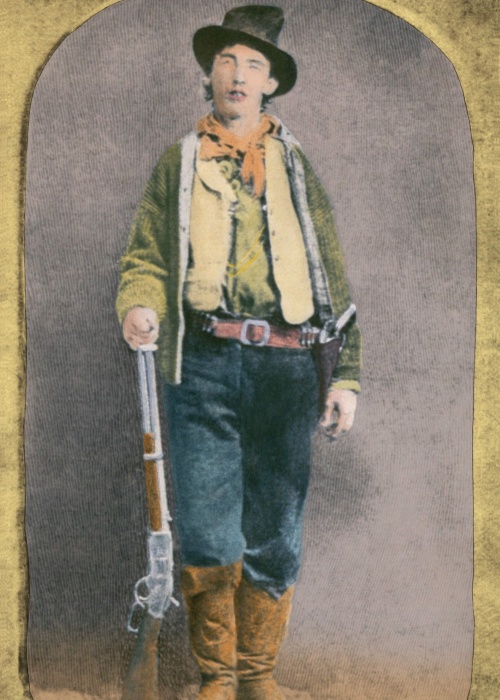
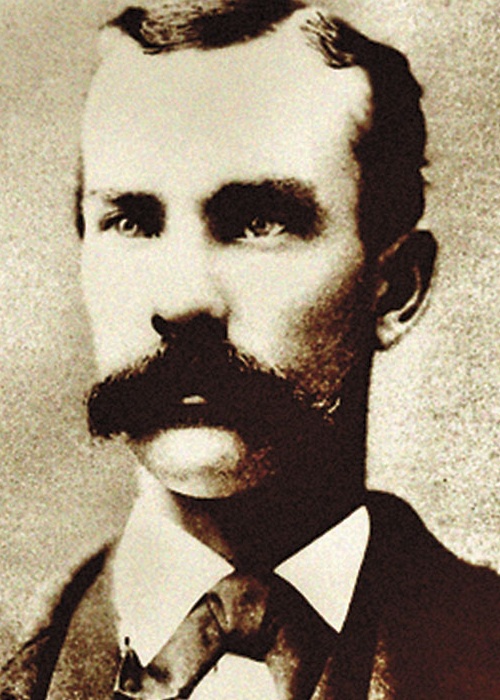
Two of the most notorious outlaws of the old West were Billy the Kid and Johnny Ringo. In Stagecoach the nickname John Wayne’s character has is “The Ringo Kid”, which is a mixture of the two names even though his character is nothing like the real Billy the Kid or the real Johnny Ringo. Both Johnny Ringo and Billy the Kid have had books and films made about them, but their true stories have been lost in the mythology of the West. The truth about their lives is much less romantic than the books or films would have us believe. Both were common criminals who graduated to murder. Neither man was handsome, heroic or brave. Their very common stories were built into legends by the print media seeking to sell newspapers, books and magazines and then became complete fiction when Hollywood made films about them.
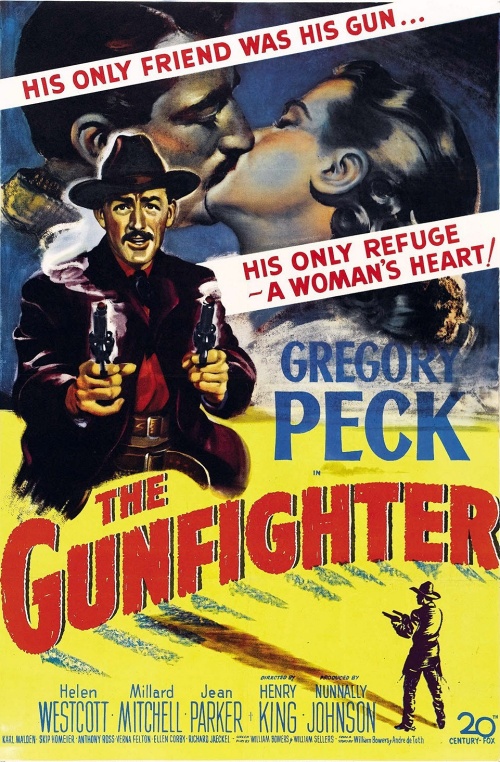
Directed by: Henry King
Produced by: Nunnally Johnson
Written by: William Bowers & William Sellers
Starring: Gregory Peck, Helen Westcott, Millard Mitchell, Jean Parker, Karl Malden
Music by: Alfred Newman
Running time: 85 minutes
Box Office: $1,950,000
Part 1 – Let us recall that Arthur Penn’s film, The Left Handed Gun (1958), showed us how the life of an outlaw can begin. Billy the Kid started his life of crime young and died when he was only twenty-one years old. In contrast to this, Henry King‘s film, The Gunfighter, shows us how the life of crime can end. King was in most ways the opposite of Arthur Penn. Penn was part of the “Hollywood New Wave” and broke with many of the old traditions of Hollywood storytelling. King was pure old Hollywood and helped establish many of those Hollywood traditions Penn would break. Almost a decade older than John Ford, King directed more than one hundred films in his long career, all but four of them before Arthur Penn directed his first film, The Left Handed Gun. King had previously directed another highly successful Western, Jesse James (1939). James was perhaps the most famous of all western outlaws, but King’s movie was almost entirely fictional. The same is true with The Gunfighter. It is as much a fictionalized account of the life of the real Johnny Ringo as his film of James was, or for that matter, the tale Arthur Penn told about Billy the Kid. In this way, King and Penn were quite similar.
In general, Westerns take the names of real people in history (Billy the Kid, Jesse James, Johnny Ringo) or real events in history (the cattle drive along the Chisolm trail, the Mormon wagon train expedition to southern Utah) and create completely different characters or stories. They “fictionalize” history. This makes for some wonderful films, but it also leads to a great deal of confusion about American history because far more Americans watch movies than study history. Many Americans (and many foreigners) tended to believe that the stories Hollywood told were actually true. There are very few Hollywood Westerns that come close to depicting history or historical figures accurately.
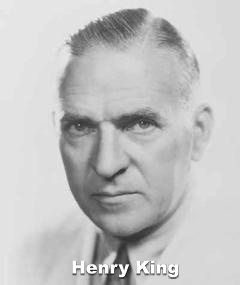
So, to be clear, The Gunfighter is no more a truthful account of the real Johnny Ringo’s life than The Left Handed Gun is of Billy the Kid’s life. However, while both films are almost entirely fictional, they are also both serious attempts to examine the character and psychology of the professional criminal (or outlaw as they were called in the west).
In this scene Jimmy Ringo (the name has been changed from Johnny to Jimmy) confronts a situation he seems all too familiar with.
Part 2 – There is one thing that is historically accurate about this scene. There were laws in almost all the Western states and territories that allowed someone to “stand their ground”. We discussed this before in Red River when Thomas Dunson threatened to whip Bob Canale. If Canale had actually reached for his gun, Dunson would have had the legal right to “stand his ground” and defend himself (with deadly force). Dunson would almost certainly have killed Canale and even if there had been a Marshall or Sheriff there witnessing the killing, he would not have been able to arrest Dunson because Canale would have been the one to “draw first”. So, there was a legal reason for a man not to “draw first” (he might be charged with murder if he won). The truth is that most gunfights in the old west were confusing, messy affairs in which two (or more), usually drunken, men tried to kill each other in any way they could and few people who witnessed the fight could say who drew first (or if they, did they give conflicting accounts). There were very few gunfights that looked as “clean” and obvious as this one.
In Red River Dunson was threatening Canale with a whipping which was an insult to his honor. Canale had only two choices; accept being dishonored or reach for his gun. Fortunately, Matt was there to save him. But in this gunfight in the saloon between Johnny Ringo and Eddie, it is the snot nosed kid, Eddie, who simply won’t be satisfied until he gets to fight the famous Jimmy Ringo. Jimmy tries very hard not to allow Eddie to provoke him into a fight, but Eddie insists. Please note that when Jimmy tells him to “button your britches and go home” it finally gives Eddie an excuse to pretend that his honor has been insulted. He insists Jimmy “explain that remark” which is really insisting he apologize. Eddie has now backed Jimmy into a dilemma where he can back down or defend his honor. Eddie has simply created a situation where Jimmy has no choice but to fight. Foolish? Insane? Suicidal? Certainly. When the older men mention the name “Jimmy Ringo” they understand who and what he is. The true professional gunfighter or gunslinger was a very, very rare person. All men carried guns and many of them were quite good with their guns. But a Gunfighter was better than good. A gunfighter like Jimmy Ringo would be comparable to a swordsman like Musashi Miyamoto. Samurai are all master swordsman, but it would simply be foolish, insane and suicidal for an ordinary samurai to challenge a master like Musashi.
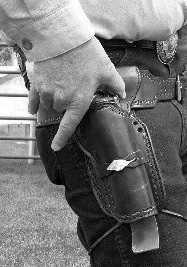
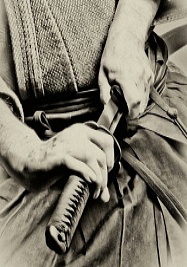
Eddie “draws first” and is instantly killed. Drawing first (at least in the movies) is almost a guarantee that you will lose. This is also true in Jidai Geki. When two swordsmen stand face to face, it is almost always the one who draws first who loses. Why? In the philosophy of sword fighting and gunfighting it is because the sword and the gun are simply expressions of the fighters will or spirit. A sword or gunfight is won or lost before the sword or gun is ever drawn. Drawing first is almost always a sign that that person’s will or spirit has broken. The legendary fight between Musashi and Kojiro is a variation on this. Musashi tells Kojiro “you have already lost” before they even exchange blows because on drawing his sword Kojiro let his scabbard fall to the ground.
At least Kojiro was a worthy opponent for Musashi. Eddie challenging Jimmy Ringo was just a stupid kid getting himself killed. However, as the cowboy tells Jimmy, law or not, witnesses or not, Eddie has three brothers who will come looking for revenge.
Part 3 – Of course, Jimmy Ringo could easily have killed the brothers, but he doesn’t seem very interested in killing anyone. He could now safely get away, but instead only goes to the next town where he is again recognized. This time he meets an old friend and explains why he has come to the town
Part 4 – The Marshall of the town, Mark, is not only an old friend of Jimmy’s, but also a former member of his gang. He has three other men with him, but tells them “Don’t try to jump him”. If anyone knows just how dangerous Jimmy is, Mark does. But he isn’t afraid of Jimmy. The two men understand and respect each other. Although, when Jimmy sees that Mark has become a law man he says “You’re kidding?” Actually, outlaws and lawmen were the same sorts of men and it was not uncommon for a former outlaw to become a lawman. Who else would be tough enough to handle the other outlaws?
There are some genuinely subtle directorial choices in this scene, as well. When the saloon keeper’s wife brings the coffee and puts it on a table in the center of the room, Jimmy moves it to a table where he can have his back to the wall. He doesn’t say anything, he just does it. He is afraid of anyone getting behind him.
Mark asks him whether he keeps track of how many men he has killed (twelve with Eddie) and Jimmy tells him “don’t ask dumb questions”. It seems the question is dumb because Jimmy knows exactly how many men he has killed. Unlike Thomas Dunson, it seems Jimmy genuinely regrets having killed so many men. But whether he regrets it or not, it has made him famous.
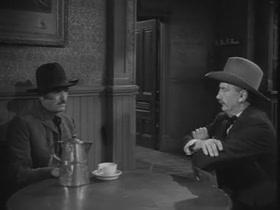
Part 5 – As Jimmy waits to hear whether his wife, Peggy, will agree to see him, the little boys of the town gather outside the saloon pushing their noses against the windows to see the famous gunfighter. This was before the age of either movies or professional sports, so the “heroes” little boys looked up to were the famous gunfighters or lawmen whose names were famous throughout the west. They argue with each other about who is the deadliest killer the way children today argue about who is the best baseball pitcher or most talented actress. One of the little boys, Jimmy Walsh, is actually Ringo’s own son. He does not know him of course because he ran away from his wife and child when the boy was just a baby.
Jimmy Ringo’s fame also attracts another “tough boy” like Eddie who wants to try his luck against Ringo.
Part 6 – The waiting continues and we become aware that the three brothers have found new horses and guns and are rapidly approaching the town. As he continues to wait, a young rancher named Tommy enters the saloon.
Part 7 – Jimmy Ringo was played by Gregory Peck who was thirty-four years old when he played the character who says that he is thirty-five “And I don’t even own a good watch”. The real Johnny Ringo was shot and killed at the age of thrifty-two. Gregory Peck was famous for playing characters who face moral dilemmas or choices and in The Gunfighter he is clearly a man who regrets the choices he has made. He hears the young rancher, Tommy, describe his simple life and obviously thinks that if he had made different choices he might have been as happy as Tommy. He then asks Mark how he escaped the life of crime and Mark tells him of an incident in which he saw a child killed accidentally by a gunfight he was involved in. That was clearly Mark’s breaking point. He simply could not continue being what he was, so he changed. He was lucky because he still had time to do so.
Time is always being mentioned in the film. Jimmy is always looking at the clock and thinking about how much time he has before the three brothers arrive. But the truth is that Jimmy is already out of time. The choices he has made over the years have led him to where he is and who he is; a man without a good watch…or a home, or a wife…or a child. He is a man with nothing. Jimmy, years ago, ran away from his wife and child because he chose to continue his life as an outlaw. Why come back now after all these years? What does Jimmy Ringo want? At long last his wife agrees to see him and he tells her what is on his mind.
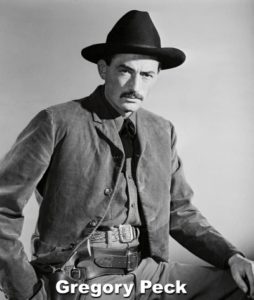
Part 8 – So, what does Jimmy Ringo want? He says that he wants to “just be someplace” with just his wife and his child. He wants to “be someplace” because he realizes just how lost he is. When a man reaches this point in his life, when he sees just how terrible his choices have been and where they have led him, he may at last be ready to seek redemption.
Remember what redemption is? We talked about redemption when we studied Stagecoach. If someone comes to understand that they have done wrong and lost the respect of their community and their loved ones, they may seek redemption. Dallas, Doc and Hatfield all sought and achieved redemption in Stagecoach. Dallas, of course, had actually done nothing wrong. She was forced to become a prostitute by circumstances and her outcast status was due to her being the victim of social prejudice. Doc, however, really did behave badly. He stole Mr. Peacock’s whiskey just so he could get disgustingly drunk. As Hatfield said “A fine member of the medical profession! A drunken beast!” But both Doc and Dallas achieve redemption by helping Mrs. Mallory safely give birth to her baby. But, the one who pays the highest price for his redemption is Hatfield. Hatfield was not even his real name. He had apparently done something so disgraceful that he had to change his name and leave his home state and go west. But, at last when he finds Mrs. Mallory, he can redeem himself by protecting her from harm. The price of that redemption is, however, his own life.
Redemption comes when others see you as redeemed, as when Mr. Peacock calls Doc “Doctor Boone” or when he invites Dallas to come and visit his house and meet his wife and children. But redemption also comes when someone sees themselves as redeemed, when they can at last overcome their feelings of shame and regain their self-respect. This is what Hatfield is trying to say with his dying breath, “If you see Judge Greenfield, tell him his son…” and he dies before he can say it, but this is actually okay because we know what he felt. Hatfield felt that he had at last paid his debt and was redeemed.
Jimmy Ringo is trying hard. He is trying not to kill anyone despite the fact they are trying to kill him. He is trying to get his wife and child back. Let us now turn to the final moments of Jimmy Ringo. in the next scene one of the deputies has just arrested the brothers who were hunting him. His wife Peggy has told him he can return in a year and as he turns his horse to leave, he believes he is on the road to redemption.